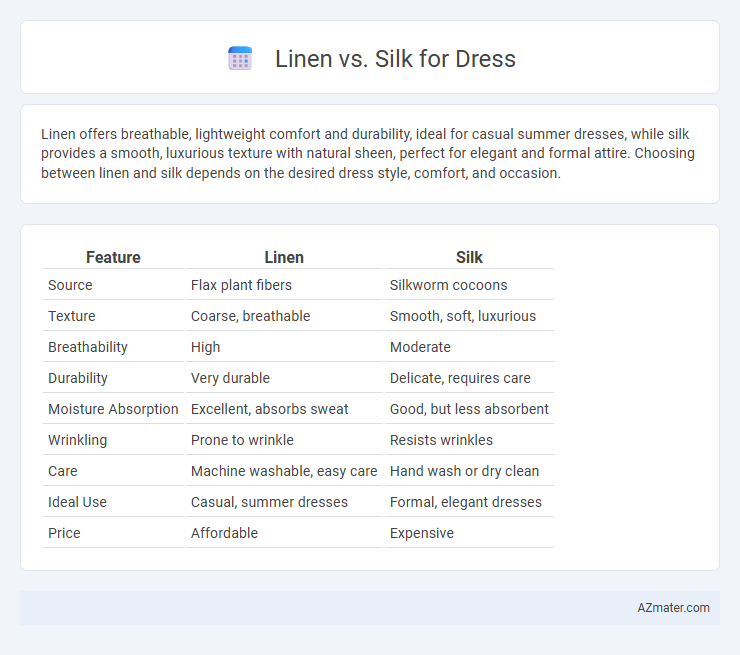Linen offers breathable, lightweight comfort and durability, ideal for casual summer dresses, while silk provides a smooth, luxurious texture with natural sheen, perfect for elegant and formal attire. Choosing between linen and silk depends on the desired dress style, comfort, and occasion.
Table of Comparison
| Feature | Linen | Silk |
|---|---|---|
| Source | Flax plant fibers | Silkworm cocoons |
| Texture | Coarse, breathable | Smooth, soft, luxurious |
| Breathability | High | Moderate |
| Durability | Very durable | Delicate, requires care |
| Moisture Absorption | Excellent, absorbs sweat | Good, but less absorbent |
| Wrinkling | Prone to wrinkle | Resists wrinkles |
| Care | Machine washable, easy care | Hand wash or dry clean |
| Ideal Use | Casual, summer dresses | Formal, elegant dresses |
| Price | Affordable | Expensive |
Introduction: Comparing Linen and Silk for Dresses
Linen and silk are two luxurious fabrics commonly used in dressmaking, each with distinct qualities suited for different occasions and climates. Linen offers breathability, durability, and a casual yet elegant texture, ideal for warm weather and everyday wear. Silk provides a smooth, lustrous finish with natural sheen and drape, making it preferred for formal events and high-end fashion designs.
Fabric Overview: Understanding Linen and Silk
Linen is a natural fiber made from flax plants, known for its breathability, durability, and moisture-wicking properties, making it ideal for warm weather and casual dress styles. Silk, derived from silkworm cocoons, offers a smooth texture, natural sheen, and excellent drape, providing a luxurious feel and suitability for formal or evening wear. Both fabrics differ significantly in care requirements, with linen being easier to maintain and silk demanding delicate handling to preserve its quality.
Comfort and Breathability: Which Feels Better?
Linen offers exceptional breathability and moisture-wicking properties, making it ideal for hot and humid climates, while silk provides a smooth, luxurious feel with moderate breathability suitable for mild temperatures. Linen's natural fibers allow air to flow freely, keeping the skin cool and dry, whereas silk's dense weave retains some warmth but feels soft and gentle against the skin. For maximizing comfort in high heat, linen is typically preferred, but silk excels in providing a lightweight, elegant drape with a subtle temperature-regulating effect.
Aesthetic Appeal: Texture and Visual Differences
Linen offers a natural, matte finish with a slightly coarse texture that creates a casual, breathable look ideal for warm weather dresses. Silk provides a smooth, lustrous surface with a reflective sheen, enhancing elegance and sophistication in formal or evening wear. The visual contrast between linen's rustic charm and silk's glossy refinement caters to different style preferences and occasions.
Durability and Longevity: Which Lasts Longer?
Linen is known for its exceptional durability and natural breathability, making it resistant to wear and tear over time, ideal for everyday dresses. Silk, while luxurious and smooth, is more delicate and prone to damage from friction and sunlight, requiring careful maintenance to preserve its longevity. For long-lasting dresses, linen generally outperforms silk due to its robust fiber structure and ease of care.
Care and Maintenance: Cleaning Linen vs Silk
Linen requires gentle washing with mild detergent and can often be machine washed on a delicate cycle, while silk demands hand washing or dry cleaning to preserve its delicate fibers and sheen. Linen is more durable and resistant to frequent washing, but silk is prone to shrinking, color fading, and damage from harsh chemicals or high temperatures. Proper care for linen involves air drying and ironing on medium heat, whereas silk requires air drying away from direct sunlight and ironing on low heat with a protective cloth.
Environmental Impact: Sustainability of Linen and Silk
Linen, derived from flax plants, is highly sustainable due to its low water consumption, minimal pesticide use, and biodegradability, making it an eco-friendly textile choice. Silk production involves intensive labor and resource use, including mulberry cultivation and silkworm farming, which can impact biodiversity and energy consumption, though natural silk remains biodegradable and renewable. Choosing linen over silk significantly reduces environmental footprint through its efficient cultivation and processing methods, aligning better with sustainable fashion goals.
Price Comparison: Cost of Linen vs Silk Dresses
Linen dresses typically cost significantly less than silk dresses due to the more affordable raw material and simpler production process, with prices often ranging from $50 to $150 for linen compared to $150 to $500 or more for silk. The higher price of silk dresses reflects the labor-intensive harvesting and weaving of silk fibers, as well as its luxurious smooth texture and sheen. Consumers seeking budget-friendly, breathable fabrics may prefer linen, while those valuing elegance and softness often invest in the higher-priced silk options.
Versatility and Occasion Suitability
Linen dresses offer exceptional breathability and a relaxed, casual elegance ideal for daytime events, beach outings, and warm-weather vacations. Silk dresses provide a luxurious sheen and smooth texture, making them perfect for formal occasions, evening wear, and sophisticated gatherings. Both fabrics excel in versatility but serve distinct purposes: linen prioritizes comfort and casual style, while silk enhances elegance and refinement.
Conclusion: Choosing the Right Fabric for Your Dress
Linen offers breathability and durability ideal for warm weather, while silk provides a luxurious, smooth texture perfect for formal occasions. Selecting the right fabric depends on the event's formality, climate, and personal comfort preferences. Prioritizing these factors ensures a dress that balances style, comfort, and practicality.

Infographic: Linen vs Silk for Dress
 azmater.com
azmater.com